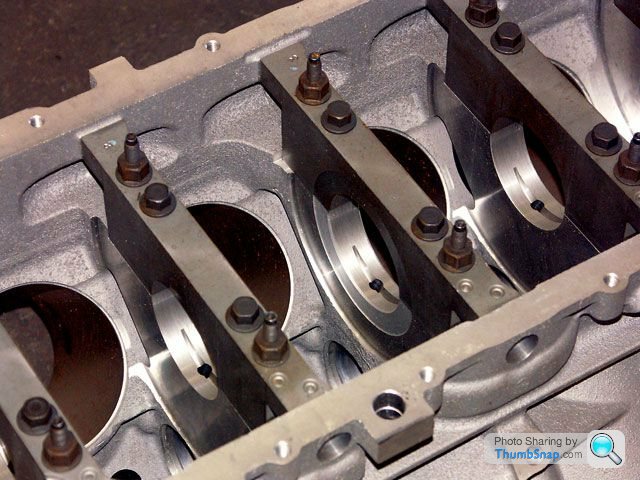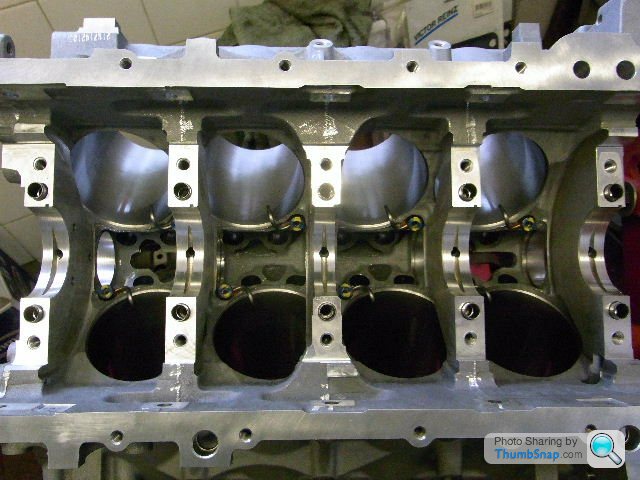What's the benefit of a cross bolted RV8?
Discussion
It increases the block strength and potential for power by keeping the crankshaft more stable at higher revs and under heavy load, as a stable crankshaft will twist and deflect less under heavy load, so it will be far less likely to break than a less stable one.
ETA To remove line talking b ks about no TVR engines being crossbolted as standard.
ks about no TVR engines being crossbolted as standard. 
ETA To remove line talking b
 ks about no TVR engines being crossbolted as standard.
ks about no TVR engines being crossbolted as standard. 
Edited by V8 GRF on Wednesday 31st July 13:04
V8 GRF said:
It increases the block strength and potential for power by keeping the crankshaft more stable at higher revs and under heavy load, as a stable crankshaft will twist and deflect less under heavy load, so it will be far less likely to break than a less stable one.
Thank you. Is it more essential with modified cars? When were they fitted as standard?I think any engine would benefit from being more rigid but I guess it becomes apparent/necessary/desirable with an uprated engine.
Hmm according to the Wikipedia entry cross bolting was introduced in 1995 to the LandRover engines so maybe I'm wrong about no TVR engines being crossbolted? I guess it all depends on which engines TVR were basing their builds on. (As he says ^^^^^^)
http://en.wikipedia.org/wiki/Rover_V8_engine
Hmm according to the Wikipedia entry cross bolting was introduced in 1995 to the LandRover engines so maybe I'm wrong about no TVR engines being crossbolted? I guess it all depends on which engines TVR were basing their builds on. (As he says ^^^^^^)
http://en.wikipedia.org/wiki/Rover_V8_engine
My pre-cat Griffith has a cross-bolted 4.6 by virtue of a V8 Developments short engine upgrade. IMO it makes for much smoother power delivery and less low revs shunting. The guys at V8 Developments can explain the detailed mechanical advantages in a TVR setup so it might be worth contacting them.
X- bolting on the rover helps the stability of the main caps a lot which in turn reduces friction and vibration
all 500's apart from the very 1st few griff 500's should be x-bolted and all of the 4.5 ltr engines will have it apart from the SEAC's and 450 wedges
its a pretty desirable option I 'd say
all 500's apart from the very 1st few griff 500's should be x-bolted and all of the 4.5 ltr engines will have it apart from the SEAC's and 450 wedges
its a pretty desirable option I 'd say
lestershaw said:
How can a numpty like me tell if its cross bolted?
Lester
There are obvious round boss's on the block just above the sump line on each side of the block.Lester
If it's cross bolted then these will be drilled and have a black, (iirc) shouldered bolt running through these from left to right and visa versa into the mains caps.
There are 5 on each side iirc.
I seem to remember being told that only the later 500s had cross bolting, and that some of the earlier ones could be a little fragile as a consequence. The engine Rob (V8 Racing) used for my upgrade to 5 litres was a non-cross bolted, externally balanced one (listen carefully and you will hear the sound of a whole new can of worms being opened), and he cross bolted and internally balanced it as part of the engine build.
one off the biggest benefits to a factory cross bolted block, is the fact they run the stronger 2.5" main journal crank, as said earlier all 450 chims are cross bolted, the 500 ran the the small journal (non cross bolted to about 1998 ish!!, I do believe all 500's 99 on are cross bolted but who knows with tvr!, cross bolting certainly helps with cap walk or (fretting) (main caps moving) but for me would be the benefit of the stronger crank, I have seen quite a few pre crossbolted cranks snap.
Out of interest none of the tvr Tuscan engines where cross bolted, they ran what is called a girdle, this was a piece of billet alloy that was machined to go in between the blck and sump, the girdle basically housed all the caps in one and bolted to the original sump bolts.
Out of interest none of the tvr Tuscan engines where cross bolted, they ran what is called a girdle, this was a piece of billet alloy that was machined to go in between the blck and sump, the girdle basically housed all the caps in one and bolted to the original sump bolts.
v8 racing said:
one off the biggest benefits to a factory cross bolted block, is the fact they run the stronger 2.5" main journal crank, as said earlier all 450 chims are cross bolted, the 500 ran the the small journal (non cross bolted to about 1998 ish!!, I do believe all 500's 99 on are cross bolted but who knows with tvr!, cross bolting certainly helps with cap walk or (fretting) (main caps moving) but for me would be the benefit of the stronger crank, I have seen quite a few pre crossbolted cranks snap.
Out of interest none of the tvr Tuscan engines where cross bolted, they ran what is called a girdle, this was a piece of billet alloy that was machined to go in between the blck and sump, the girdle basically housed all the caps in one and bolted to the original sump bolts.
There were also a few 2.300" 'X' blocks but they're pretty scarce these days.Out of interest none of the tvr Tuscan engines where cross bolted, they ran what is called a girdle, this was a piece of billet alloy that was machined to go in between the blck and sump, the girdle basically housed all the caps in one and bolted to the original sump bolts.
v8 racing said:
one off the biggest benefits to a factory cross bolted block, is the fact they run the stronger 2.5" main journal crank, as said earlier all 450 chims are cross bolted, the 500 ran the the small journal (non cross bolted to about 1998 ish!!, I do believe all 500's 99 on are cross bolted but who knows with tvr!, cross bolting certainly helps with cap walk or (fretting) (main caps moving) but for me would be the benefit of the stronger crank, I have seen quite a few pre crossbolted cranks snap.
Out of interest none of the tvr Tuscan engines where cross bolted, they ran what is called a girdle, this was a piece of billet alloy that was machined to go in between the blck and sump, the girdle basically housed all the caps in one and bolted to the original sump bolts.
There you have it, from the man who spends his working hours up to the elbows in RV8 engines. No better authority. Out of interest none of the tvr Tuscan engines where cross bolted, they ran what is called a girdle, this was a piece of billet alloy that was machined to go in between the blck and sump, the girdle basically housed all the caps in one and bolted to the original sump bolts.

Gassing Station | General TVR Stuff & Gossip | Top of Page | What's New | My Stuff






